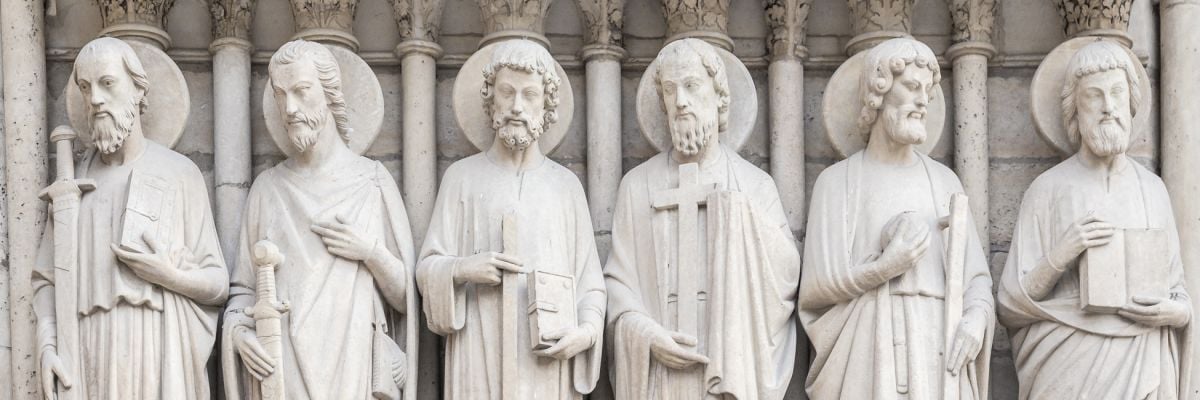
Tim Staples answers a caller who objects to Catholicism in part because she believes statues in churches are graven images of the sort prohibited in Exodus 20:4.
Host: We are going to go to Anonymous in Syracuse, Indiana. Anonymous, are you with us?
Caller: Yes I am.
Tim: And guess what the question is?
Host: The question is: why are you Protestant?
Caller: Why am I Protestant? Okay, well, like many others, I’m Protestant mostly because I was born Protestant. I was raised in an Anabaptist family. My parents were Amish, I was raised Mennonite; and I live in a very large Mennonite community, and honestly Catholicism was never even on my radar.
Tim: I can relate.
Caller: Yeah, like in high school I think maybe we had one Catholic family, you know. And then the little touches that I had with Catholicism, just, I wasn’t interested. Like, I went to a Catholic wedding and it was ridiculous. You know, like everybody was drunk and it was crazy and it was just like, I couldn’t–
Host: I can assure you, Anonymous, having been married two years ago in the Catholic Church, the wedding with my wife was nothing like that, so that must have been an anomaly.
Tim: And mind you, it wasn’t the wedding; I’m sure you’re talking about the reception!
Caller: Exactly, you’re right!
Host: It would be really bad if it was at the wedding.
Caller: Right, exactly, it was the reception. But it was just, there was nothing along the way that would have made me interested at all until about three months ago. I have a long drive to work, and I was so tired of NPR, and I couldn’t, you know, I didn’t want sports talk, I find Christian radio pretty boring, and all of that. So I was just channel surfing and I found Catholic radio, I–first of all, I was just blown away. So I’ve been listening a lot the last three months, but things that have–and there’s a lot of things I don’t have an issue with, like the idea of a universal Church and a universal authority. I actually believe in that, but it’s just hard–so who should have that authority? That’s not really my question, though.
Host: Okay. So what is really getting at you, Anonymous?
Caller: Ok, so here let me tell you, so why am I not Catholic? Yes, okay. And help me with this hurdle, and it might just be personal, but it has to do with the physical part of Catholicism. Like, I would hear stories sometimes about, like, there were miracles by a Virgin Mary statue or something, and she was crying, and I just felt like that just seems crazy. Like, you know, hocus-pocus stuff or whatever.
So that was in the past; but even now today, a couple times I’ve been in Catholic churches and I find the statues really offensive. Like, personally offensive, and let me explain a little bit why: growing up in the Amish tradition, you don’t even take pictures, because those are “graven images,” you know? So like, in my home now, even though I’m no longer even Mennonite, I’m just in a mainstream Protestant Church, I don’t have nativities in my home, I don’t have pictures of Jesus in my home, I don’t wear a cross with the crucifix.
Host: That is very consistent where many Protestants are not, Anonymous.
Tim: That’s right. I really appreciate what you’re saying. You know what, I think I got the gist of this, so if I could jump in, Anonymous.
I think the key here is to understand, even from the Old Testament, that that Amish sort of Mennonite understanding is really not biblical. When you go back to the Old Testament, for example, in Exodus 20, where you have the Ten Commandments, right, “Thou shalt not make any graven image of any likeness of anything being in heaven or earth or under the sea;” if you go just five chapters later, just five chapters, in Exodus 25:18, what do you have? God commands Moses to make the Ark of the Covenant, and over the top of the mercy seat you have two enormous five-foot-tall golden angels. They’re cherubim.
And so God commands–and I love the way that it’s written there in the King James Version–it says: “Thou shalt make two golden cherubim out of beaten gold.” So wait a minute, God said “No statues,” and then He commands Moses to make a statue. And think of this as well: the Ark of the Covenant, where you have these enormous golden statues, became a source of God’s grace and God’s power for God’s people.
And then you go to Numbers 21:8-9 and you see, when Moses and the children of Israel were in the wilderness and they began to rebel against God, God sends a plague of snakes among them, Moses intercedes for them; God commands Moses once again, He says: “Make a brazen serpent, put it up on a pole,” and when the children of Israel looked to it, they were healed. Now, you and I know that in John 3:11-12 in the New Testament, we find that is a type or an image representing the coming Christ. But nevertheless, the point is: God uses stuff. He uses the physical world to be instruments whereby he brings his blessing to his people. And so even in the Old Testament you have that.
Now even though you don’t have any images of God in the Old Testament, because God in Deuteronomy 4:16 has a stricture against having images of God–but even there it’s an interesting point here, Anonymous. God tells them why. He says: “I did not command you concerning the making of images when I brought you out of Israel because I took no form among you.” So God tells them why. “I don’t want you making forms because I didn’t take a form.” Well, guess what? In the New Testament, He does: “The Word was made flesh and dwelt among us.”
And we believe, Anonymous, that in the Incarnation, now God has become flesh. And so while we only have that limited use of images in the Old Testament, we have a much fuller sense of images in the New Testament because, well, principally in Colossians chapter 1:14-15, especially verse 15, it says: “Christ is the image of God, the firstborn of all creation.” And the Greek word there for “image” is “eikon,” or “icon.” Christ is the ultimate icon because of the Incarnation. We believe that in the the Incarnation God became physical, and so he relates to us physically. Not that he didn’t in the Old; yes he did, through the ark and the the brazen serpent and such. But now it’s a much more intimate and physical relationship.
Host: So Tim, let’s pull this together, and then Anonymous, we’ll hear from you. So you’re saying, Tim, that when God said, “Do not make graven images,” He wasn’t saying, “Do not make images of any kind,” because He later commanded people to make images; rather, He was forbidding the creation of images people would worship in idolatry.
Tim: Absolutely right, Trent. And Anonymous, He’s condemning idolatry, not the making of statues, because if He was condemning the making of statues, He contradicts himself.
Host: Right, because He wouldn’t command you later to do something he said not to do before. So Anonymous, that was a lot to take in; is that helpful for what you’re searching through?
Caller: It is helpful. I do–one question that you know I’d have as a follow-up is the Old Testament and the New Testament thing, but I can read about that. I do have one more question, though, that’s related to the physical. Like, to dwell in the tabernacle–you know, do you believe that the presence of God is in the building? Like, the cathedrals or whatever? Like I go there and the presence of God dwells there? Because that’s a hang-up I have too, like in Ephesians 2 where it says “We are being built into the dwelling place of God in spirit,” and “Where two or three are gathered, I’m there in your midst.” So what what is it about, that the presence of God is in a building?
Tim: Absolutely. Here you ask a very important question. First of all, we believe, just as you do, Anonymous, that God dwells in all Christians in a special way. Through our baptism, the Holy Spirit comes to dwell within us. Matthew 18:19, which you quoted, “Where two or three are gathered together in my name, there am I in their midst,” so not only is Jesus present with us via the Holy Spirit individually through our baptism, just as when Jesus was baptized the Holy Spirit descends upon him, “This is my beloved Son, in whom I am well-pleased;” that’s, you know, Jesus didn’t need to be baptized, because he was God, but He’s showing us this is the way that, as individuals, God the Holy Spirit comes to dwell within us. So as individuals, God dwells within us. Collectively, there is a special way in which God dwells within us, as you mentioned in Matthew 18:19. So in other words, we agree with you, Anonymous, on these things.
However, there is a special way in which Christ is present in his Church, and that is in the Eucharist. Because Jesus comes, as he said in John 6:53, he said: “Unless you eat the flesh of the Son of Man and drink his blood, you have no life in you.” Jesus said “This is my body” on Holy Thursday, and St. Paul tells us, in 1 Corinthians 11:27-29, that Jesus is actually present–body, blood, soul, and divinity–in the Eucharist; and because of that fact, in the Tabernacles in all the apostolic Churches around the world that have valid Eucharist, Jesus is present in–as Trent mentioned in the last hour–in a physical reality. He’s present body, blood, soul, and divinity. So there is a special presence even beyond that individual presence where the Holy Spirit’s in us. He’s in us collectively; in Catholic Churches, he’s in the tabernacle, body, blood, soul, and divinity.
Host: Anonymous, I hope that that’s helpful. If you have other questions, call us back or go to Catholic.com.
To read more about this topic, see our articles “So Catholics Worship Statues?” and “Statues Aren’t Necessarily Idols.“



